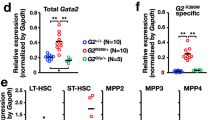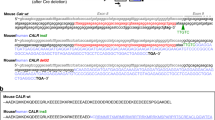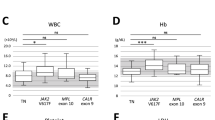Abstract
Haematopoietic development is regulated by nuclear protein complexes that coordinate lineage-specific patterns of gene expression. Targeted mutagenesis in embryonic stem cells and mice has revealed roles for the X-linked gene Gata1 in erythrocyte and megakaryocyte differentiation1,2,3,4. GATA-1 is the founding member of a family of DNA-binding proteins that recognize the motif WGATAR through a conserved multifunctional domain consisting of two C4-type zinc fingers5,6,7,8. Here we describe a family with X-linked dyserythropoietic anaemia and thrombocytopenia due to a substitution of methionine for valine at amino acid 205 of GATA-1. This highly conserved valine is necessary for interaction of the amino-terminal zinc finger of GATA-1 with its essential cofactor, FOG-1 (for friend of GATA-1; refs9,10,11,12). We show that the V205M mutation abrogates the interaction between Gata-1 and Fog-1, inhibiting the ability of Gata-1 to rescue erythroid differentiation in an erythroid cell line deficient for Gata-1 (G1E). Our findings underscore the importance of FOG-1:Gata-1 associations in both megakaryocyte and erythroid development, and suggest that other X-linked anaemias or thrombocytopenias may be caused by defects in GATA1.
This is a preview of subscription content, access via your institution
Access options
Subscribe to this journal
Receive 12 print issues and online access
$209.00 per year
only $17.42 per issue
Buy this article
- Purchase on Springer Link
- Instant access to full article PDF
Prices may be subject to local taxes which are calculated during checkout





Similar content being viewed by others
References
Pevny, L. et al. Erythroid differentiation in chimaeric mice blocked by a targeted mutation in the gene for transcription factor GATA-1. Nature 349, 257–260 (1991).
Weiss, M.J., Keller, G. & Orkin, S.H. Novel insights into erythroid development revealed through in vitro differentiation of GATA-1− embryonic stem cells . Genes Dev. 8, 1184–1197 (1994).
Fujiwara, Y., Browne, C.P., Cunniff, K., Goff, S.C. & Orkin, S.H. Arrested development of embryonic red cell precursors in mouse embryos lacking transcription factor GATA-1. Proc. Natl Acad. Sci. USA 93, 12355– 12358 (1996).
Shivdasani, R.A., Fujiwara, Y., McDevitt, M.A. & Orkin, S.H. A lineage-selective knockout establishes the critical role of transcription factor GATA-1 in megakaryocyte growth and platelet development. EMBO J. 16, 3965–3973 ( 1997).
Tsai, S.F. et al. Cloning of cDNA for the major DNA-binding protein of the erythroid lineage through expression in mammalian cells. Nature 339, 446–451 (1989).
Evans, T. & Felsenfeld, G. The erythroid-specific transcription factor Eryf1: a new finger protein. Cell 58, 877–885 (1989).
Orkin, S.H. GATA-binding transcription factors in hematopoietic cells. Blood 80, 575–581 ( 1992).
Weiss, M.J. & Orkin, S.H. GATA transcription factors: key regulators of hematopoiesis. Exp. Hematol. 23, 99–107 (1995).
Tsang, A.P. et al. FOG, a multitype zinc finger protein, acts as a cofactor for transcription factor GATA-1 in erythroid and megakaryocytic differentiation . Cell 90, 109–119 (1997).
Tsang, A.P., Fujiwara, Y., Hom, D.B. & Orkin, S.H. Failure of megakaryopoiesis and arrested erythropoiesis in mice lacking the GATA-1 transcriptional cofactor FOG. Genes Dev. 12, 1176– 1188 (1998).
Fox, A.H., Kowalski, K., King, G.F., Mackay, J.P. & Crossley, M. Key residues characteristic of GATA N-fingers are recognized by FOG. J. Biol. Chem. 273, 33595– 33603 (1998).
Crispino, J.D., Lodish, M.B., MacKay, J.P. & Orkin, S.H. Use of altered specificity mutants to probe a specific protein-protein interaction in differentiation: the GATA-1:FOG complex. Mol. Cell 3, 219–228 (1999).
White, J.G. Use of the electron microscope for diagnosis of platelet disorders. Semin. Thromb. Hemost. 24, 163–168 (1998).
McDevitt, M.A., Shivdasani, R.A., Fujiwara, Y., Yang, H. & Orkin, S.H. A “knockdown” mutation created by cis-element gene targeting reveals the dependence of erythroid cell maturation on the level of transcription factor GATA-1. Proc. Natl Acad. Sci. USA 94, 6781–6785 (1997).
Vyas, P., Ault, K., Jackson, C.W., Orkin, S.H. & Shivdasani, R.A. Consequences of GATA-1 deficiency in megakaryocytes and platelets. Blood 93, 2867– 2875 (1999).
Kowalski, K., Czolij, R., King, G.F., Crossley, M. & Mackay, J.P. The solution structure of the N-terminal zinc finger of GATA-1 reveals a specific binding face for the transcriptional co-factor FOG. J. Biomol. NMR 13, 249– 262 (1999).
Fox, A.H. et al. Transcriptional cofactors of the FOG family interact with GATA proteins by means of multiple zinc fingers. EMBO J. 18, 2812–2822 (1999).
Martin, D.I.K. & Orkin, S.H. Transcriptional activation and DNA binding by the erythroid factor GF-1/NF-E1/Eryf 1. Genes Dev. 4, 1886–1898 (1990).
Yang, H.-Y. & Evans, T. Distinct roles for the two cGATA-1 fingers. Mol. Cell. Biol. 12, 4562– 4570 (1992).
Trainor, C.D. et al. A palindromic regulatory site within vertebrate GATA-1 promoters requires both zinc fingers of the GATA-1 DNA-binding domain for high-affinity interaction. Mol. Cell. Biol. 16, 2238– 2247 (1996).
Gregory, T. et al. GATA-1 and erythropoietin cooperate to promote erythroid cell survival by regulating bcl-xL expression. Blood 94, 87–96 (1999).
Weiss, M.J. & Orkin, S.H. Transcription factor GATA-1 permits survival and maturation of erythroid precursors by preventing apoptosis. Proc. Natl Acad. Sci. USA 92, 9623– 9627 (1995).
Yomogida, K. et al. Developmental stage- and spermatogenic cycle-specific expression of the transcription factor GATA-1 in mouse Sertoli cells. Development 120, 1759–1766 ( 1994).
Viger, R.S., Mertineit, C., Trasler, J.M. & Nemer, M. Transcription factor GATA-4 is expressed in a sexually dimorphic pattern during mouse gonadal development and is a potent activator of the Mullerian inhibiting substance promoter. Development 125, 2665 –2675 (1998).
Hutson, J.M., Baker, M., Terada, M., Zhou, B. & Paxton, G. Hormonal control of testicular descent and the cause of cryptorchidism. Reprod. Fertil. Dev. 6, 151–156 (1994).
Thompson, A.R., Wood, W.G. & Stamatoyannopoulos, G. X-linked syndrome of platelet dysfunction, thrombocytopenia, and imbalanced globin chain synthesis with hemolysis. Blood 50, 303–316 (1977).
Weiss, M.J., Yu, C. & Orkin, S.H. Erythroid-cell-specific properties of transcription factor GATA-1 revealed by phenotypic rescue of a gene-targeted cell line. Mol. Cell. Biol. 17, 1642–1651 ( 1997).
Acknowledgements
We thank Y. Fujiwara, E. Neufeld and S. McKenzie for helpful insights and discussions; D. Haber for assistance with DNA sequencing and review of the manuscript; and J. Mackay and M. Crossley for insightful discussions and providing data on the three-dimensional structure of the GATA-1 N-terminal zinc finger. This work was supported in part by NIH grants AI K11AI01331-05 (K.E.N.), R01 CA78545 (J.M.M.) and HL40387 (M.P.).
Author information
Authors and Affiliations
Corresponding author
Rights and permissions
About this article
Cite this article
Nichols, K., Crispino, J., Poncz, M. et al. Familial dyserythropoietic anaemia and thrombocytopenia due to an inherited mutation in GATA1. Nat Genet 24, 266–270 (2000). https://doi.org/10.1038/73480
Received:
Accepted:
Issue Date:
DOI: https://doi.org/10.1038/73480
This article is cited by
-
Bromodomain and extraterminal (BET) proteins: biological functions, diseases, and targeted therapy
Signal Transduction and Targeted Therapy (2023)
-
Ribonuclease inhibitor 1 (RNH1) deficiency cause congenital cataracts and global developmental delay with infection-induced psychomotor regression and anemia
European Journal of Human Genetics (2023)
-
Germline GATA1 exon 2 mutation associated with chronic cytopenia and a non-down syndrome transient abnormal myelopoiesis with clonal trisomy 21
Leukemia (2022)
-
Confounding factors in the diagnosis and clinical course of rare congenital hemolytic anemias
Orphanet Journal of Rare Diseases (2021)
-
Inherited Macrothrombocytopenia: Correlating Morphology, Epidemiology, Molecular Pathology and Clinical Features
Indian Journal of Hematology and Blood Transfusion (2018)



